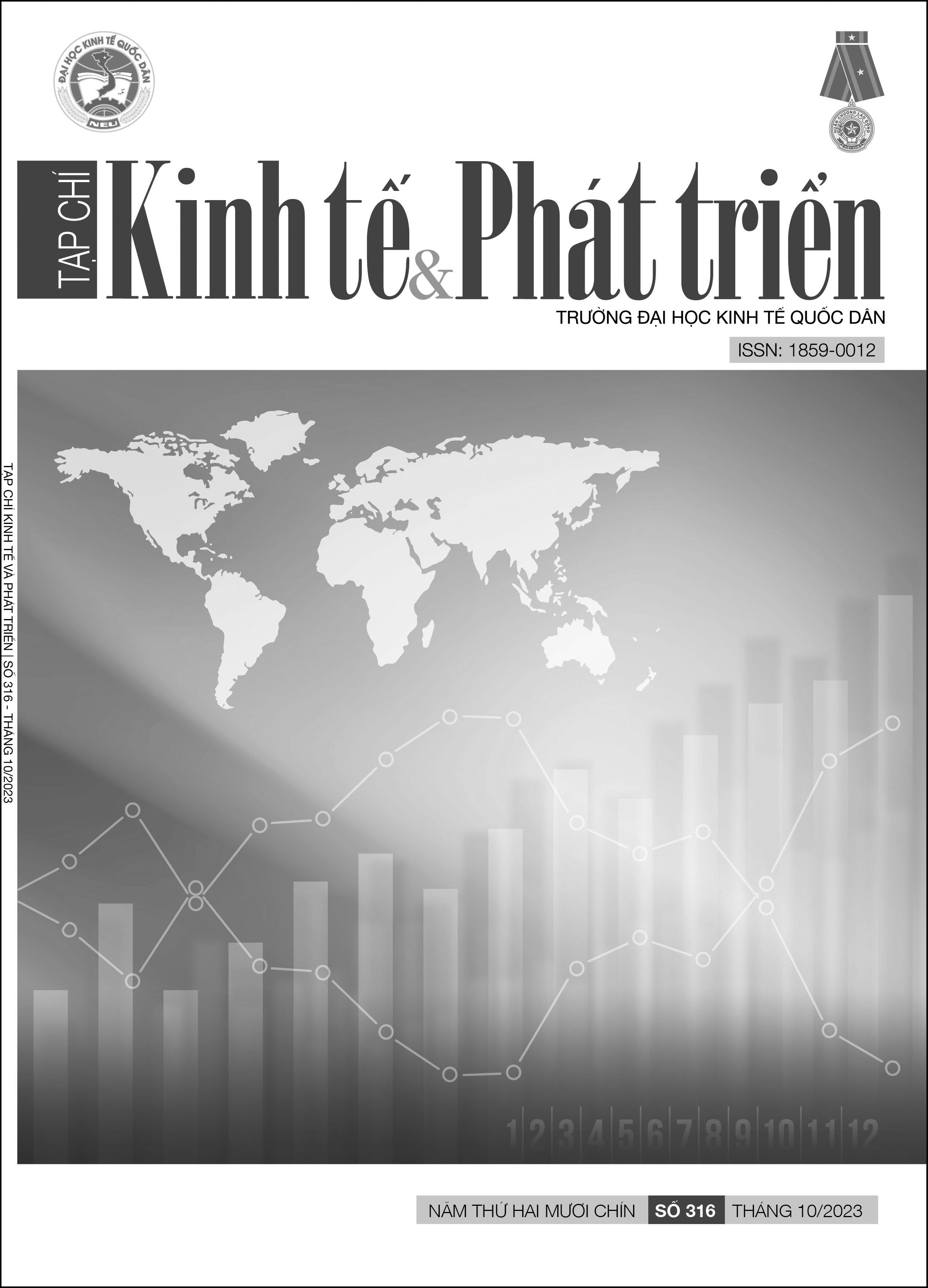Ảnh hưởng của ô nhiễm bom mìn đến phúc lợi hộ gia đình tại Việt Nam
DOI:
https://doi.org/10.33301/JED.VI.1408Từ khóa:
Ô nhiễm bom mìn, phúc lợi hộ gia đình, Việt NamTóm tắt
Việt Nam là một quốc gia chịu ảnh hưởng nặng nề của chiến tranh và dư âm để lại là sự ô nhiễm nghiêm trọng của bom mìn, vật nổ. Tuy thế, có khá ít nghiên cứu xem xét ảnh hưởng của ô nhiễm bom mìn đến phúc lợi hộ gia đình tại Việt Nam. Vì vậy, nghiên cứu đóng góp vào tổng quan bằng việc cung cấp những bằng chứng định lượng đầu tiên về chủ đề này. Sử dụng mô hình kinh tế lượng vi mô với dữ liệu ô nhiễm bom mìn và điều tra mức sống dân cư tại Việt Nam năm 2018 và 2020, nghiên cứu phát hiện ra rằng ô nhiễm bom mìn có tác động tiêu cực đối với thu nhập của các hộ gia đình. Ô nhiễm bom mìn cũng ảnh hưởng nghiêm trọng đến sinh kế nông nghiệp, từ đó làm giảm thu nhập của các hộ gia đình. Kết quả hàm ý rằng làm sạch ô nhiễm do bom mìn là một vấn đề cấp bách để xây dựng một môi trường an toàn và bền vững cho tất cả mọi người.
Tài liệu tham khảo
Abadie, A., & Gardeazabal, J. (2003), ‘The economic costs of conflict: A case study of the Basque Country’, American Economic Review, 93(1), 113-132.
Andersson, N., Dasousa, C. P., & Paredes, S. (1995), ‘Social costs of landmines in four countries – Afghanistan, Bosnia’, Cambodia and Mozambique British Medical Journal, 311, 718–721.
Arcand, J.-L., Rodella-Boitreaud, A.-S., & Rieger, M. (2015), ‘The impact of land mines on child health: Evidence from Angola’, Economic Development and Cultural Change, 63(2), 249–279.
Asadoliahi, R., Saghajinia, M., Najissi, N., Montazeri, A., Liahi, M. A., & Khatami, A. (2010), ‘Anxiety, depression and health-related quality of life in those injured by landmines, Ham, Islamic Republic of Iran’, Eastern Mediterranean Health Journal, 16 (11), 1108–1114.
Azariadis, C., & Drazen, A. (1990), ‘Threshold externalities in economic development’, Quarterly Journal of Economics, 105(2), 501–526.
Barceló, J. (2021), ‘The long-term effects of war exposure on civic engagement’, Proceedings of the National Academy of Sciences, 118(6).
Bolton, M. (2010), ‘Foreign aid and landmine clearance’, London: IB Touris & Co Ltd.
Clodfelter, M. (1995), ‘Vietnam in Military Statistics: A History of the Indochina Wars’, 1772- 1991, London: McFarland & Company.
Darwish, R., Farajalla, N., & Masri, R. (2009), ‘The 2006 war and its inter-temporal economic impact on agriculture in Lebanon’, Disasters, 33(4), 629–644.
Do, T. L., Nguyen, T. T., & Grote, U. (2019), ‘Non-farm employment and household food security: Evidence from panel data for rural Cambodia’, Food Security, 11(3), 703–718.
Drèze, J. (2000), ‘Militarism, development and democracy’, Economic and Political Weekly, 35(14), 1171–1183.
Everitt, B. S., Landau, S., Leese, M., & Stahl, D. (2011), Cluster analysis, New York: John Wiley & Sons, https://doi.org/10.1002/9780470977811
Frost, A., Boyle, P., Autier, P., King, C., Zwijnenburg, W., Hewitson, D., & Sullivan, R. (2017), ‘The effect of explosive remnants of war on global public health: a systematic mixed-studies review using narrative synthesis’, The Lancet Public Health, 2(6), e286-e296.
Gunaratnam, H. R., Gunaratnam, S., & Somasundaram, D. (2003), ‘The psychosocial effects of landmines in Jaffna’, Medicine, Conflict and Survival, 19(3), 223–234.
Guo, S. (2020), ‘The legacy effect of unexploded bombs on educational attainment in Laos’, Journal of Development Economics, 147, 102527.
Landmine & Cluster Munition Monitor (2007), ‘Country reports: Vietnam’, In Landmine monitor report 2007, http://archives.the-monitor.org/index.php/publications/display?url= lm/2007/vietnam.html
Martin, M. F., Dolven, B., Feickert, A., & Lum, T. (2019), ‘War legacy issues in Southeast Asia unexploded ordnance (UXO)’, Current Politics and Economics of South, Southeastern, and Central Asia, 28(2/3), 199–230.
Merrouche, O. (2008), ‘Landmines and poverty: IV evidence from Mozambique. Peace Economics’, Peace Science and Public Policy, 14(1), 23–38.
Merrouche, O. (2011), ‘The long term educational cost of war: evidence from landmine contamination in Cambodia’, The Journal of Development Studies, 47(3), 399-416.
Miguel, E., & Roland, G. (2011), ‘The long-run impact of bombing Vietnam’, Journal of Development Economics, 96(1), 1–15.
Nagler, P., Naudé, W., & Naude, W. (2014), ‘Non-farm enterprises in rural Africa: New empirical evidence’, World Bank Policy Research Working Paper, No. 7066.
Nguyen, C. V., Tran, T. Q., & Vu, H. V. (2022a), ‘The long-term effects of war on foreign direct investment and economic development: Evidence from Vietnam’, GLO Discussion Paper, No. 1047, Global Labor Organization.
Nguyen, C. V., Tran, T. Q., & Vu, H. V. (2023), ‘Does foreign direct investment benefit local firms? Evidence from a natural experiment study’, The World Economy, Online first
Nguyen, T. N., Tran, T. Q., & Vu, H. V. (2022b), ‘Unexploded ordnance contamination and household livelihood choice in rural Vietnam’, Russian Journal of Economics, 8 (2022), 276–294.
O’Reilly, S., Friedman, J., Dinsmore, H., Storr, R., & MacPherson, R. (2012), Meta evaluation of mine action and development final report, Sheffield: Publishing.
Palmer, M., Nguyen, C. V., Mitra, S., Mont, D., & Groce, N. E. (2019), ‘Long-lasting consequences of war on disability’, Journal of Peace Research, 56(6), 860–875, https://doi.org/10.1177/ 0022343319846545.
Rigg, J. (2006), ‘Land, farming, livelihoods, and poverty: Rethinking the links in the rural South’, World Development, 34(1), 180–202.
Rutherford, K. R. (2011), Disarming states, the international movement to ban landmines, Singapore: Praeger Security International.
Singhal, S. (2019), ‘Early life shocks and mental health: The long-term effect of war in Vietnam’, Journal of Development Economics, 141(11), 102244.
Tilly, C. (1975), The formation of national states in Western Europe, Princeton: Princeton University Press
Tổng cục Thống kê (2017), Thông cáo báo chí về tình hình kinh tế – xã hội năm 2017, https://www.gso.gov.vn/du-lieu-va-so-lieu-thong-ke/2019/10/thong-cao-bao-chi-ve-tinh-hinh-kinh-te-xa-hoi-nam-2017
Tran, T. Q. (2014), ‘A review on the link between non-farm employment, land and rural livelihoods in developing countries and Vietnam’, Ekonomski Horizonti, 16(2), 113–123.





